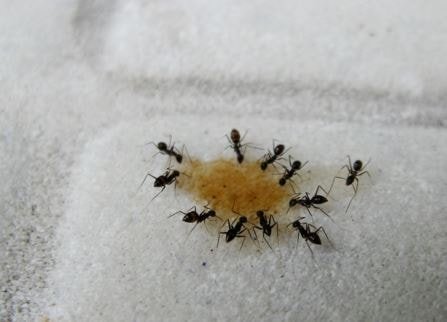Sugar Ants
What are Sugar ants and what do they look like?
Sugar ants is a term for small scavenger ants that are attracted to sweet, sugars and other leftover food; these are what we usually see crawling in the kitchen or dining area, they bite but it doesn’t sting. They belong to Camponotus species. Sugar ants in general are little, ranging to 1/3 – ½ inch or 2 – 15 mm in size.

Most of the sugar ants are polymorphic by nature; they assume different size and form depending on the type of work and habitat they have. The bigger worker ants have the larger in body diameter compared to that small worker ant.
How to search for Sugar Ants?
Habitat also changes their size because in every place they nest, it provides them different types of food. Female sugar ants are usually yellowish to brown, while the male sugar ants are darker or black tint in color.
Where do sugar ants live?
There are different kinds of sugar ants and each has its own kind of habitat. Being able to identify the several different kinds of sugar ants and its habitat, is a big help on answering the problem on determining the appropriate course of action in treatment, how to control and get rid of this pest.
Here are some of the common examples:
- Pharaoh ants, with its scientific name of Monomorium pharaonis, is a small yellowish to brown, with a darker or black color, marking on their abdominal area with the size of 1/16-inch, or 2.0 millimeters in length. Pharaoh ants preferably live on a moist area, like the kitchen, sink, bathroom, and drain that’s why they are known to be a foremost indoor pest.
- They eat almost any kind of food, but most preferable to sweets. Pharaoh ants multiply fast because of its polygynous nature, it has a thousand of workforces and has two or more queens in a colony, and each queen lays eggs about four hundred to five hundred eggs in their entire life.
- Thief ants, with the scientific name of Solenopsis molesta. They get their name because of its nesting behavioral habit on building a nest beside or near to other ant habitat, in which they filch food or even occupy their neighbor ant colony.
- Thief ants are also called as grease ants because it is attracted more on greasy foods. They also feed on larvae, dead insect or rats and sputum. Thief ants are the smallest sugar ant with the size of 1/32 – 1/8 inch or 0.5 mm – 3 mm in length with the tone color of yellowish to brown.
- Because of its small size; they can nest anywhere that is dark and hidden, they can live in any corner of the house, sides of the door, under the appliances or cabinets. Outdoor they usually nest under the rock, soil, lawns, gardens and decomposed woods. Thief ant swarms on the month of June too late fall on that season mating takes place.
- Pavement ants, with the scientific name of Tetramorium caespitum. They are called pavement ants because they nest on pavement-like crack walls, under the floor, bricks, gates or any concrete area. These sugar ants are what we usually see in our house as tiny, dark brown to black in color.
- They are antagonistic in nature; they will attack other colonies and triumph over the habitat. They also tend to do that because they have a defense mechanism of transferring to one location to another in order to protect the colony from a fluctuating weather. This ants does not bite, but has a stinging ability.
How to get rid of Sugar Ants?
-
Tips on getting rid of sugar ants
Tired of seeing marching ants on you on your kitchen or crawling on your dining table or food? Here are some tips on getting rid of this infestation:
Baiting – This is usually the initial and easy way to attract and trap sugar ants. You can use bait in tracking the sugar ant’s colonies by giving them foods with gradual acting insecticide so they don’t die that rapidly and still can transport the food to their colony and share it to the remaining ants. Once you locate their habitat, you can treat the habitat immediately with insecticides. This is an effective way for pharaoh ants since they have too many queens.
Professional pest control support – You can call a pest control expert or company whenever your plan and efforts have failed. Let them classify the species of the sugar ant and execute proper and effective resolution.
How to prevent sugar ants from coming back?
Prevention is way better and cheaper than cure. There are so many ways on preventing sugar ants from infesting. Here are a few tips:
- Let’s keep the kitchen and dining area dry and clean.
- Wipe the dining tables with clean rag after eating; put the leftover into a plastic bag and put it on the bin.
- Make sure not to leave the dishes unwashed on the sink, clean the sink and pour a small amount of detergent or bleach and let it dry.
- Always sweep or vacuum the flooring because leftovers can be on the floor, then mop it with detergent or bleach.
- You can also wash down the empty used beverage bottles or cans before disposal.
- Make it a habit of taking out of trash in a daily basis.
References
web Sources:
- SUGAR ANTS HABITAT – http://www.pest-control.com/ants/sugar-ants/sugar-ants-habitat/
- http://www.terro.com/ants-control
- http://www.orkin.com/ants/sugar-ants/
Books:
- Ants, Mickey Daronco, Lori Priesti,2010
- Ants, Julie Murray,2010
- Ants, Suzanne Slade,2007
